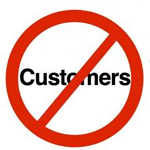 When Ben and I talk to potential clients about the costs associated with doing a newsletter it is often met with dismay. Yes, it is a lot of money.
When Ben and I talk to potential clients about the costs associated with doing a newsletter it is often met with dismay. Yes, it is a lot of money.
Neither of us are going to beat around the bush. However at the same time the investment relative to the return is miniscule.
Are you interested in income or equity?
Now Ben and I have actually just gone through annual reviews with our first three clients – all them have had financially positive results. That is, they have made more than they have spent usually in multiples of their investment. With one breaking even. (They work in the slow market of real estate and didn’t send their newsletter to the most likely prospects for them this year.)
So yes, there is a lot of money to spend to do a newsletter but on the income side they are at least as well off directly because of the newsletter.
One client, Cariss Printing have had clients who have been steadily spending less with them over the last 5 years jump in their purchasing from them. Often as much as a 5X jump. The only difference being the client started receiving a print newsletter each month.
What we haven’t yet been able to help our clients measure is the change in equity in their business (and if all we could show after a year of working with them is ‘equity’ then I would see our activity as a failure). That siad The chickens will really come home to roost in the future, when they all decide that it is time to sell up their business. That is when you get paid for the equity you have created.
Customers = Equity
An ongoing purchasing relationship with your clients is often the only form of equity a business can create. Thankfully, it is also the best. Business owners complain bitterly about the good old days when customer loyalty was a given. It is still there, but customers are only loyal to those who deserve it now, it is no longer a given.
These days, you the business owner need to invest in the relationship in order to be rewarded with the loyalty. This equity (in the form of loyalty/retention) changes the value proposition of your business.
No longer when you sell up is your buyer facing the proposition that they are buying some ‘physical stuff’ when they buy your business, they are buying future income from guaranteed and know sources. This is an incredible difference.
There is equity and future income to be had from your existing customers. Think long and hard before you choose to neglect them because it costs ‘too much to retain them.’
 Somewhere along the line being a Nerd became cool. Beauty and The Geek and The Big Bang Theory have become staples the country’s nightly television viewing (I challenge you to find a night where Big Bang isn’t on).
Somewhere along the line being a Nerd became cool. Beauty and The Geek and The Big Bang Theory have become staples the country’s nightly television viewing (I challenge you to find a night where Big Bang isn’t on). It has been a fun 12 months for us here at Newsletter Marketing Systems.
It has been a fun 12 months for us here at Newsletter Marketing Systems.
 From a long time now we have been in the business of helping clients get more repeat business and referrals.
From a long time now we have been in the business of helping clients get more repeat business and referrals. I have developed a bit of an unnatural relationship with the show Gold Rush. After watching Todd, Jack, Dakota Fred and Parker through two and a bit seasons all I can say is I take perverse pleasure in watching a train wreck happen. Gold Rush is also a touching story about America’s pioneering spirit and rediscovering the American Dream. (Or more darkly: Then they dug for their gold till the land was forsaken and wrote it all down as the progress of man.)
I have developed a bit of an unnatural relationship with the show Gold Rush. After watching Todd, Jack, Dakota Fred and Parker through two and a bit seasons all I can say is I take perverse pleasure in watching a train wreck happen. Gold Rush is also a touching story about America’s pioneering spirit and rediscovering the American Dream. (Or more darkly: Then they dug for their gold till the land was forsaken and wrote it all down as the progress of man.)
 Ben and I were speaking on the phone the other day. We were having an interesting conversation about the difference between people that get marketing and those that don’t.
Ben and I were speaking on the phone the other day. We were having an interesting conversation about the difference between people that get marketing and those that don’t.